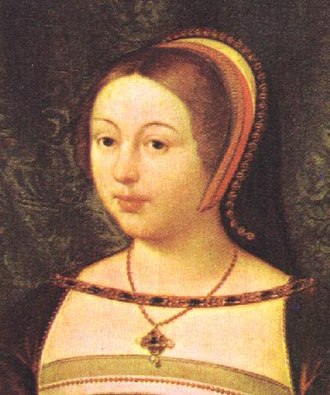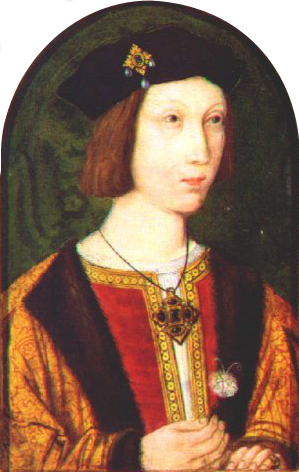In January 1486, a papal dispensation for the marriage of Henry VII and Elizabeth of York was granted to 'end the long and grevious variance, contentions and debates' between England's warring factions. Henry was almost 29 and Elizabeth was almost 20. On that occasion the theme of divine intervention on behalf of Henry VII was deliberately promoted and widely believed. Not long after the wedding, the queen found herself pregnant with her first son, Arthur, and gave birth on 20 September 1486. By March 1489 the queen was pregnant again and on the 29 November she delivered a baby girl, Margaret. Eighteen months later her third child, Henry, was born at Greenwich Palace, alongside the River Thames, five miles (8km) east of London, on 28 June 1491.

Henry VII.

Elizabeth of York, wife to Henry VII and mother to Henry VIII.
A few days after his birth, Henry VIII was baptised in the newly built church of the Order of the Franciscan Observants that adjoined Greenwich Palace immediately to the west. Immediately after the christening, Mistress Anne Oxenbridge took charge of the baby as his wet nurse on a salary of £10 a year, or nearly £5,000 a year at current values. Anne cared for Henry for at least two years and his grandmother, Lady Margaret (Henry VII's mother), ordered that 'her meat and drink be assayed [tested] during the time that she gives suck to the child and that a physician do oversee her at every meal, [who] shall see that she gives the child seasonable meat and drink after he had progressed to solid foods.' The wet nurse was assisted in her duties by two official 'rockers' of the royal cradle - Frideswide Puttenham and Margaret Draughton.
Henry probably shared the royal nursery with his two-year-old sister Margaret (his brother Arthur was raised elsewhere), although they lived in separate accommodation and had their own female attendants. While the queen frequently stayed in the same building as her children, everyday care and love always devolved upon paid staff. However, Elizabeth of York was probably well educated, and it may be that she taught Henry to read and write when he was about four years of age.
In their early years, the royal children had a peripatetic existence, shifting from one palace to another as their mother travelled with the seasons, following the set regal diary of events, which was sometimes linked to religious festivals. Their elder brother, Arthur, meanwhile had an entirely separate life, spending his first two years at Farnham castle, before his nursery was moved to Ashford in Kent around 1488. When Arthur was seven he was taken to Ludlow where he learnt the duties of a king, complete with his own household and council, administering his principality of Wales. Meanwhile, his younger brother's life during this time was spent in a very cloistered and cosy feminine world at Eltham. As the only boy at this royal houselhold, Henry was thoroughly spoilt and tenderly protected from the hard knocks and bruises of childhood misfortune. The toddler prince was cossetted, his grumpiness and tears cooed away, and his every whim swiftly fulfilled by the doting matronly ladies who cared for him.
Did this period in Henry's early life forge a deep psychological flaw within him that later created some of the personal difficulties that arose in his relationships with his wives? Some psychiatrists have detected in him an unconscious craving for a forbidden incestuous union - even signs of an Oedipus complex. Certainly that soft, compliant female world may have planted and nurtured the seeds of his terrible temper in adulthood (one inherited by his daughter Elizabeth); the breathtaking tantrums that assailed courtier or commoner when he was denied what he desired or confronted by any kind of opposition, however feeble or insignificant the source.
It did not take long before Henry VII reasoned it was time to exploit the appeal and status of the second son. On April 1493 the king made the infant Henry Lord Warden of the fourteen Cinques Ports on the south-east coast of England and Constable of Dover Castle. It was a highly symbolic act. Not only was a royal prince now nominally in charge of the realm's defensive front line, but the appointment was also deliberately linked with the name of a famous memory. Further prestigious offices followed: Earl Marshal of England and then, on September 1494, his appointment as Lord Deputy of Ireland. He was also created Duke of York and a knight of the most honourable order of the Bath. All this when Henry was barely three years old.
The toddler was confronted with a seemingly impossible test of infant nerve and stamina. He was to be at the centre of an unintelligible and interminable series of elaborate rituals, full of strange sounds and vibrant colours, and amid a host of strangers, all in the unfamiliar and intimidating surroundings of Westminister. Perhaps Henry was anxious to demonstrate his royal bearing, even at an early age. Certainly, these occasions spawned his later delight in gaudy pagentry and lavish ceremonial, which was also a delight inherited by his daughter, Elizabeth. On 17 May 1495, at the age of four, young Henry received the Garter, the highest order of chivalry in England.
Henry VII fourth child, Elizabeth, born 2 July 1492, began displaying signs of ill health in 1495. Unknown to the royal physicians, she was suffering from atrophy, a wasting disease caused by the breakdown of her body's tissues and on 14 September Henry's sibling and playmate died at Eltham Palace, aged three years and two months. Very early in life, Henry was made aware of the fragility and precariousness of life - no doubt an anxiety which haunted him during the years to come when his own children were born.
The loss of Elizabeth was eased by the birth of another sister, Mary on 18 March 1496, who joined Margaret and Henry in the nursery at Eltham.
| Margaret Tudor |
|---|
 |
| Arthur |
|---|
| Prince of Wales |

|


Henry VII fifth child, Mary.
Henry's first public duty came at Windsor on 21 September 1496, when he was aged five. This was his formal witnessing of a royal grant of a charter to the abbot and convent of Glastonbury to hold two annual fairs in the Somerset town. Paradoxically, forty-three years later as king, he destroyed the abby during the Dissolution of the Monasteries and had its last abbot brutally hanged for high treason.
Meanwhile, Elizabeth of York had given birth to another son, named Edmund after the king's father, on Friday 20 February 1499. There were now three sons in direct line of succession to the Tudor crown. But not for long. Edmund died on 19 June 1500 and was buried in Westminister Abbey.
In 1501, Katherine of Aragon, Arthur's intended bride, left Granada to England for the wedding. Aged sixteen and described as 'pink-cheeked with blue eyes and reddish-gold hair', she was also noted unkindly as slightly on the plump side and quite short, even tiny. Arthur was fifteen, 'half a head shorter than her, with a pallor to his face and lips.' On the 14 November 1501 their marriage took place in St Paul's Cathedral. Ten-year-old Henry was granted the honour of giving the bride away. Henry escorted Katherine in her dazzling entrance into the city of London two days before the wedding. It was the first sight of the girl who was to preoccupy his life, for better, for worse, for more than three decades. A spectacular wedding ensued. Edward Hall was beside himself with excitement, stunned by the splendour of 'the rich apparel of the princess, the strange fashion of the Spanish nation, the beauty of the English ladies, the goodly demeanour of the young damsels, the amarous countenence of the lusty bachelors'.
Shortly before Christmas the newly-weds left the Palace of Richmond to begin their new life together on the Welsh borders at Ludlow Castle. On April 1502 - less than twenty weeks after that sumptuous wedding - Arthur was dead and cold in his bed. The cause of death: probably tuberculosis. Henry was now the unexpected and untrained heir-apparent to the throne. In just over a 1,000 days, Death had now cruelly snatched two of the three Tudor Princes - a foreshadowing of Henry's own future fate in his attempt to secure an heir to his throne.
In 1503, another disaster befell the House of Tudor. Elizabeth had fallen pregnant a few months after Arthur's death. With two daughters living, the king and queen had hoped desperately for a second boy to firmly secure the line of Tudor succession. During the night of 2 February, the queen 'travailed suddenly of a child' but with the assistance of her midwife, Alice Massy, safely gave birth to a daughter, christened Katherine. A few days later Elizabeth fell ill, possibly of a puerperal fever arising from an infection picked up during birth. Early on the morning of Saturday 11 February 1503, Elizabeth died. It was her thirty-seventh birthday. Henry VII had lost his gentle, blond and fair-skinned wife of eighteen years, and of the eight children she had borne him, only three now survived - Margaret, Mary and Henry.
Much later Henry VIII wrote of his thoughts on the death of the king of Castile, recalling his great grief at the loss of his mother:
For never, since the death of my dearest mother, has there come to me more hateful intelligence. Your letter ... seemed to tear open again the wound to which time had brought insensibility.

Sources: Robert Hutchinson Young Henry.



